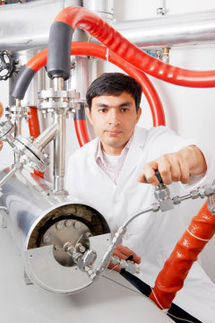A method that paves the way for improved fuel cell vehicles
More efficient and longer-lasting fuel cells are essential for fuel cell-powered heavy-duty hydrogen vehicles to be an alternative to combustion fuelled counterparts. Researchers at Chalmers University of Technology, Sweden, have developed an innovative method to study and understand how parts of fuel cells degrade over time. This is an important step towards the improved performance of fuel cells and them becoming commercially successful.

Researchers at Chalmers University of Technology, Sweden, have developed an innovative method to study and understand how fuel cells degrade over time, using advanced electron microscopes . This is an illustration of a catalyst layer sample on a transmission electron microscope grid, placed between an electrode and a gas diffusion layer. Credit
Chalmers University of Technology | Linnéa Strandberg and Victor Shokhen
Hydrogen is a fuel alternative that is becoming increasingly interesting for heavy-duty vehicles. Hydrogen-powered vehicles only emit water vapour as exhaust, and if the hydrogen is produced using renewable energy, it is completely free of carbon dioxide emissions. Unlike battery-powered electric vehicles, hydrogen-powered vehicles do not need to burden the electricity grid, as hydrogen can be produced and stored when electricity is cheap. For some hydrogen-powered vehicles the propulsion comes from a so-called fuel cell. However, hydrogen-fuel-cell-powered vehicles are limited by a relatively short lifespan, because fuel cell components, such as electrodes and membranes, degrade over time. It is this problem that the recent study addresses.
Researchers at Chalmers University of Technology have developed a new method for studying what affects the ageing of fuel cells by tracking a specific particle in the fuel cell during use. The team of researchers have studied an entire fuel cell by taking it apart at regular intervals. Using advanced electron microscopes, they have then been able to follow how the cathode electrode degrades in specific areas during the cycles of use. Previous studies have been done on so-called half-cells, which are similar (but not the same as) half of a fuel-cell and are carried out under conditions that differ significantly from the real fuel cell.
Better understanding with new experimental method
"It has previously been assumed that the performance would be affected by the fuel cell being disassembled and studied in the way we have done, but it turned out that this assumption is not correct, which is surprising," says research leader Björn Wickman, Associate Professor at the Department of Physics at Chalmers.
The researchers at Chalmers have been able to explore how the material in the fuel cell degrades at both the nano and micro level, and pinpoint exactly when and where the degradation occurs. This provides valuable information for the development of new and improved fuel cells with a longer lifespan.
"From previously only looking at how the fuel cell has aged after use, we have now been able to look into the middle stage," says doctoral student Linnéa Strandberg at Chalmers. “Being able to follow a single, chosen particle within a specific area, provided a much better understanding of the degradation processes. Greater knowledge of these is an important step on the way to designing new materials for fuel cells or to adjust the control of the fuel cell.”
New method paves way for longer lasting fuel cells
The U.S. Department of Energy (DOE) has pointed out that improved lifetime of fuel cells is one of the most important goals to reach before fuel cell-powered hydrogen vehicles can become commercially successful. According to the industry, a truck needs to be able to withstand 20,000 – 30,000 hours of driving over its lifetime, which a fuel cell-powered hydrogen truck cannot achieve today.
"We have now laid a foundation on which to build for the development of better fuel cells. Now we know more about the processes that take place in the fuel cell and at what point over the lifetime of the fuel cell they occur. In the future, the method will be used to develop and study new materials that can give the fuel cell a longer lifespan," says Björn Wickman.
Original publication
Other news from the department science
Most read news
More news from our other portals
See the theme worlds for related content
Topic World Battery Technology
The topic world Battery Technology combines relevant knowledge in a unique way. Here you will find everything about suppliers and their products, webinars, white papers, catalogs and brochures.

Topic World Battery Technology
The topic world Battery Technology combines relevant knowledge in a unique way. Here you will find everything about suppliers and their products, webinars, white papers, catalogs and brochures.





























































